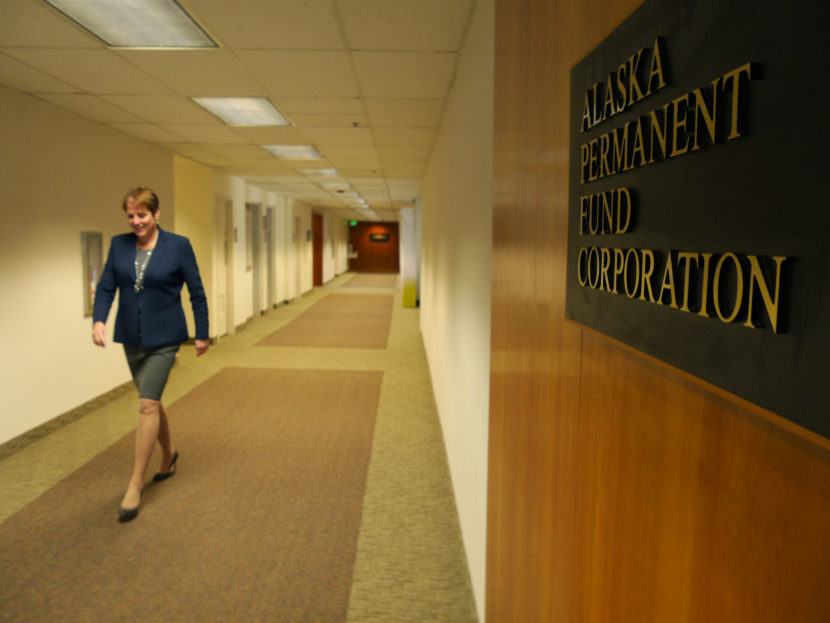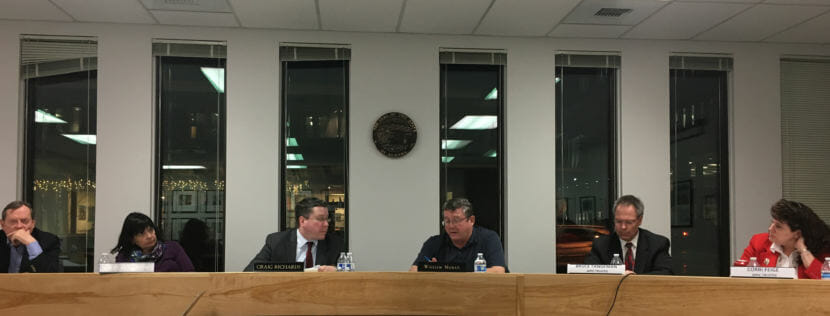
The Alaska Permanent Fund Corporation wants to start paying its investment managers something called incentive compensation. That would mean that state employees who manage the fund’s investments would be paid in part based on how the fund itself performs. That could help recruit talented managers — and keep the ones who are already here.
The corporation’s board supports the policy, but it’s up to Gov. Mike Dunleavy’s administration and the legislature to make it happen.
The corporation used to have all of its assets managed by outside organizations. But it’s shifted an increasing share of assets to corporation employees, scaling up from 40 to 61 positions in the past four years. This has saved the state money. And it means that they’ve been doing a lot of hiring lately.
The corporation recently had a job applicant for a position managing investments. CEO Angela Rodell said the staff loved him as a candidate, and he loved the idea of moving to Juneau. They topped another job offer he had by $5,000.
“It’s taken much longer to recruit than even any of us would have thought,” she said. “And the first question we get is, ‘Do you have incentive comp, and will I be eligible for it?’”
Ultimately, the candidate took the other offer because it included an incentive worth up to 75 percent of his base salary, depending on how well his investments performed. Currently, the permanent fund doesn’t offer incentive compensation like this.
Rodell said it’s become difficult for the Permanent Fund Corporation both to recruit and to retain investment managers.
“We are on the fourth chief investment officer in the last 10 years, so that’s a pretty high turnover for that position, and that one in particular concerns the board,” she said.
The Permanent Fund Board of Trustees has adopted a policy to start paying incentives, worth up to 50 percent of investment managers’ salaries. The payments would be a small fraction of the $63.9 billion fund. For next year, these incentive payments would be up to $1.4 million.

State Revenue Commissioner Bruce Tangeman, a member of the corporation’s board, said it’s a reasonable discussion to have.
“Obviously, the permanent fund is a rather large endowment,” he said. “And it’s critical that we have the best and brightest managing that on our behalf.”
But Tangeman also said that the proposed spending increase will be scrutinized by state Office of Management and Budget Director Donna Arduin. And she’s looking to cut the budget, not add to it.
“Now that we have a new governor in place, everything will be converging at OMB, and Gov. Dunleavy has made it very clear that downsizing government is going to be critical,” he said.
Bob Maynard worked in Alaska for 17 years beginning in 1975, including time as the permanent fund’s deputy executive director. He’s now the chief investment officer of the Public Employees Retirement System of Idaho. In that system, he used to receive incentive pay, but Idaho stopped it.
He said any incentive system that depends on the legislature deciding whether to appropriate money every year is a problem. Incentives are designed so that if a person reaches a goal, they’ll receive the incentive. Maynard said that will never be certain when a governor or lawmakers could decide not to pay it.
“That is a problem,” he said. “Because if you’re the legislature, you’re sitting there saying, ‘Are we creating a band of aristocrats?’”
Maynard likes the concept of incentive pay. But he said the media and public criticized incentives paid to public employees who managed investments that lost value. That was true even when they did better than the market during the recession a decade ago.
“And it was just too much of a burden on my board, on my chair, on the governor, etc., to have to defend the headlines,” he said. “Because the press will say … it’s a bonus.”
Incentive pay schemes can be complicated. Rodell said the Permanent Fund Corporation avoided that.
“Let’s keep it very simple and straightforward and very tangible for people to grasp that investors making investment decisions will benefit from the positive decisions that they make and they won’t benefit from the negative decisions they make,” she said.
Managers would receive all of their incentive pay based on a combination of how the overall fund performs and how the particular assets that they manage perform. It would be based on performance over the past five years, with more weight given to the most recent year. The formula fits on a chart that takes up half of a page.
The Alaska Permanent Fund’s performance has been good, growing nearly $5 billion more than a benchmark over the past five years.
But Rodell is concerned that it will be a challenge to maintain that level of performance if the fund struggles to hire and keep talented investment managers.
“Not only are we asking people to move to Juneau and to Alaska, we’re asking them to take a significant pay cut from what they would be offered down in the Lower 48. So part of this is for me. It’s more about positioning for new recruits than it is for retention,” she said.
The deadline for Dunleavy’s administration to decide whether to ask the legislature for incentive compensation for the permanent fund is Feb. 13.
Andrew Kitchenman is the state government and politics reporter for Alaska Public Media and KTOO in Juneau. Reach him at akitchenman@alaskapublic.org.




